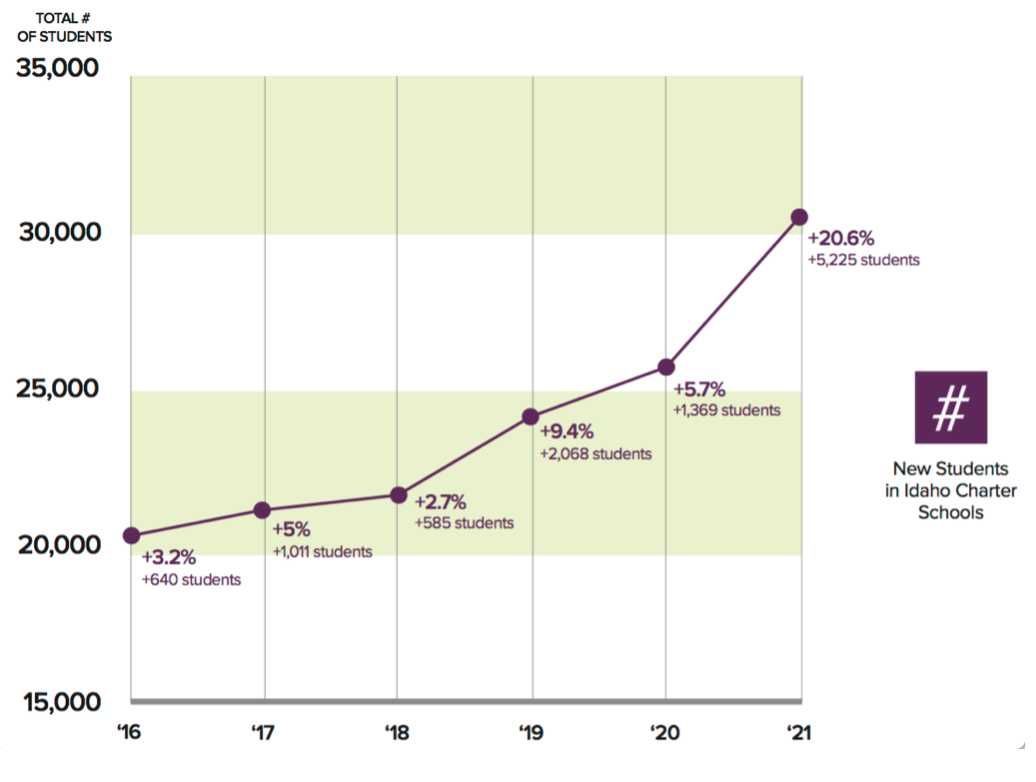Questions and confusion swirl around Idaho’s decades-old charter school movement.
What was their original purpose? How are they funded differently from traditional public schools? How do they perform?
These questions accompany the schools’ continued growth in Idaho, their mixed academic achievement and their struggles to serve minority and poor students.
Here are some facts, history and data to help set the record straight:
Are charters public schools? Yes.
Idaho’s charter schools are a tuition-free, publicly funded K-12 option. They survive on taxpayer dollars, like traditional neighborhood schools.
But charters and traditional schools are different. Unlike traditional schools, charters aren’t required to provide transportation — and some don’t. Just 36 of the state’s 62 public charters operating independently of school districts received state reimbursements for busing services last school year, according to State Department of Education numbers.
Charters can also be exclusive. Traditional public schools must find a seat for all students within their boundaries. With Idaho charters:
- Enrollment limitations have put thousands of students on waiting lists. Unlike traditional schools, charters can cap their growth — and offer available seats to would-be students through local lotteries.
- Demographics are historically less diverse than the state’s neighborhood schools, which on average serve more minorities, children with special needs and students in poverty.
- Families in many rural communities don’t have a charter school to choose from.
The following tool includes details on each of Idaho’s charter schools, including where they’re located. Click here for a closer look at charter demographics.
Were charters created to boost educational outcomes? Yes, and to provide alternatives for families.
Idaho charters were created to bring “expanded choices and innovation” to Idaho’s public education system, so school administrators could replicate “charter school successes,” according to a 2014 review from the Legislature’s Office of Performance Evaluation.
Accountability played a part from the outset. A 1997 legislative committee agreed that charters would develop accountability goals and submit progress reports to their authorizers, the 2014 report concluded. (More on charter authorizers shortly.) The extra layer of review would assure legislators and stakeholders that charters could demonstrate their success.
Do students at charters outperform those in traditional schools? On average, yes.
The average Idaho charter student outperforms their traditional school counterparts, a 2019 Stanford University study found.
Yet the study also underscored highs and lows of charter performance in Idaho.
A 2019 ranking of every school in Idaho shows five of the top 20 are charters. Still, some charters are among the state’s lowest performing. Idaho’s virtual charters especially struggle.
The Stanford study lines up with earlier EdNews investigations showing that charters underserve minority and poor student populations, though some excel at closing achievement gaps between these historically underserved populations and their K-12 peers, according to 2020 report from Boise State University's Idaho Policy Institute.
Do Idaho charters and traditional schools receive the same funding? Not really.
State dollars flow to charters the same way they flow to school districts: through an arcane formula based on average student attendance.
Both districts and charters get some state support for new facilities. An escalating stipend from the state for building projects helps charters cover some of these costs. In 2019, Gov. Brad Little signed a bill to help charters save money on their own bond payments. Many charters also tap into a range of federal and private grants to support expansion and construction projects.
The state provides limited assistance for facilities to districts, but drumming up money for new schools is really all about passing a local bond issue — something charters can't do.
On average, bond issues and other local supplemental funds help funnel more money to Idaho’s school districts. Last year, per-pupil expenditures for districts averaged $10,228. For the state’s charters, the average was $7,703.
Are charter schools still growing? Yes.
Charters absorbed most of Idaho’s K-12 growth in 2020-21 and now account for 10 percent of the state’s K-12 student population, with over 30,400 kids, according to the State Department of Education.
Their 20.6 percent enrollment increase since last school year represents their largest ever. Here’s a breakdown of charter student enrollment growth since 2016:

Do Idaho charters operate under higher academic standards than traditional schools? For the most part, yes.
Unlike traditional schools, charters must comply with oversight of charter authorizers, which can develop various accountability measures beyond those in traditional schools.
Just 10 of Idaho’s 66 charters operate under the purview of a traditional school district. The rest operate under the Idaho Public Charter Commission. Idaho law allows state universities, colleges and private, non-sectarian institutions to authorize charters, but none have done so.
The commission uses a comprehensive performance framework to decide whether or not to renew charters under its purview. These measures go beyond those used for accountability in traditional districts, but the commission has considered ways to ease up and streamline parts of the framework, which includes student achievement and financial oversight measures.
Commission-authorized charters undergo a renewal process every five years.
Can authorizers shut down struggling charters? Yes, although it doesn’t happen.
No district has closed a charter over concerns about finances or student achievement.
Since its inception in 2004, the commission has closed one, though several schools have consistently failed to meet performance expectations and make ends meet financially.
Disclosure: Bluum and Idaho Education News are both funded by the J.A. and Kathryn Albertson Family Foundation.
“More choices, more challenges” is an in-depth look at the robust effort to expand Idaho charter schools. The series considers what the well-funded push means for Idaho families and leaders and how the state is adapting to the growth. EdNews data analyst Randy Schrader provided data and information for this series. The series, at glance:
Monday
- Idaho’s charters bring more choices — and more challenges
- Facts about Idaho’s charter schools
Tuesday
Wednesday
Thursday
Friday
